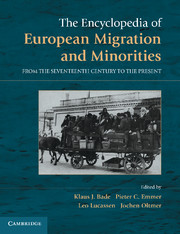Book contents
- Frontmatter
- Contents
- Preface to the English Edition
- Preface to the German Edition
- The Encyclopedia: Idea, Concept, Realization
- Terminologies and Concepts of Migration Research
- Countries
- Northern Europe
- Western Europe
- Central Europe
- Germany
- Austria
- Switzerland
- Southern Europe
- East-Central Europe
- Southeastern Europe
- Eastern Europe
- APPENDIX
- Index of Migration Types
- Index of Countries, Regions, and Places
- References
Austria
from Central Europe
Published online by Cambridge University Press: 05 June 2012
- Frontmatter
- Contents
- Preface to the English Edition
- Preface to the German Edition
- The Encyclopedia: Idea, Concept, Realization
- Terminologies and Concepts of Migration Research
- Countries
- Northern Europe
- Western Europe
- Central Europe
- Germany
- Austria
- Switzerland
- Southern Europe
- East-Central Europe
- Southeastern Europe
- Eastern Europe
- APPENDIX
- Index of Migration Types
- Index of Countries, Regions, and Places
- References
Summary
Austria’s geographic location in the heart of Europe, at the intersection of major east-west and north-south trade routes, has contributed to making the region one that has always been characterized by immigration, emigration, and transit migration. Neither the population growth nor the cultural diversity of the small and medium-size cities and of the former Habsburg capital and imperial residence of Vienna would be conceivable without immigration and the cultural baggage that the migrants brought with them over the centuries.
The region and its boundaries
Österreich, the German name for Austria, goes back to an Old German rendering of the Latin phrase orientalia regna, the “eastern land.” It referred to the Danubian region east of the river Enns, which was the eastern boundary of the original Bavarian region. From about the middle of the 12th century, a Latin neologism austria was substituted for ostarrîche, using a Latinization of the German root “austar” (East). In the 14th and 15th centuries, the phrase “Dominion of Austria” (dominium austrie) was used: it encompassed the territories of modern-day Lower and Upper Austria, Styria, Carinthia, Carniola, the Windische Mark, Inner Istria, and Tyrol, along with the Habsburg ancestral lands around the upper Rhine in Swabia and Alsace. Triest, Freiburg im Breisgau, and some counties in what is now Vorarlberg were added a little later.
- Type
- Chapter
- Information
- The Encyclopedia of European Migration and MinoritiesFrom the Seventeenth Century to the Present, pp. 83 - 93Publisher: Cambridge University PressPrint publication year: 2011
References
- 1
- Cited by



